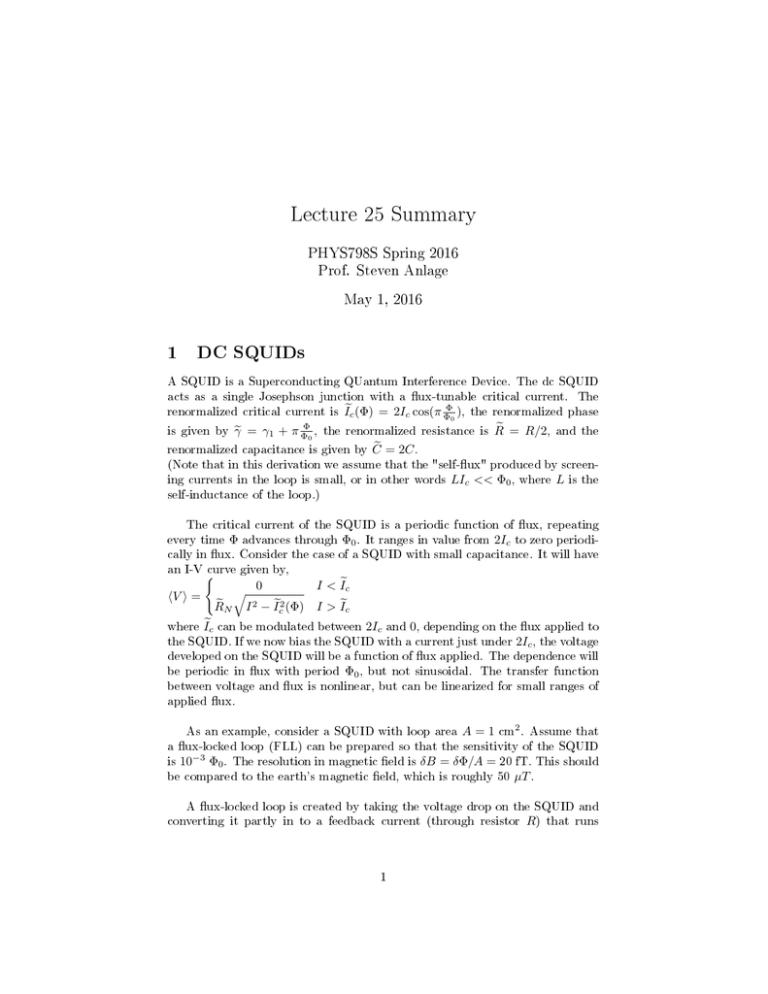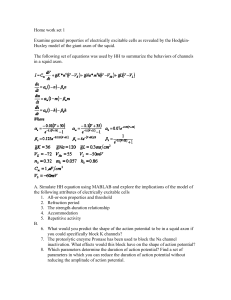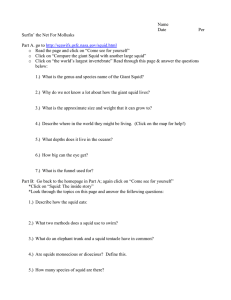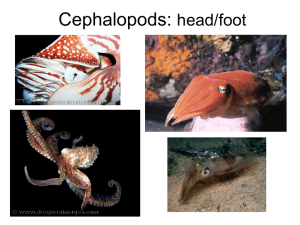Lecture 25 Summary
advertisement

Lecture 25 Summary PHYS798S Spring 2016 Prof. Steven Anlage May 1, 2016 1 DC SQUIDs A SQUID is a Superconducting QUantum Interference Device. The dc SQUID acts as a single Josephson junction with a ux-tunable critical current. The renormalized critical current is Iec (Φ) = 2Ic cos(π ΦΦ0 ), the renormalized phase is given by γe = γ1 + π ΦΦ0 , the renormalized resistance is Re = R/2, and the renormalized capacitance is given by Ce = 2C . (Note that in this derivation we assume that the "self-ux" produced by screening currents in the loop is small, or in other words LIc << Φ0 , where L is the self-inductance of the loop.) The critical current of the SQUID is a periodic function of ux, repeating every time Φ advances through Φ0 . It ranges in value from 2Ic to zero periodically in ux. Consider the case of a SQUID with small capacitance. It will have an I-V (curve given by, hV i = I < Iec q 0 eN I 2 − Iec2 (Φ) I > Iec R where Iec can be modulated between 2Ic and 0, depending on the ux applied to the SQUID. If we now bias the SQUID with a current just under 2Ic , the voltage developed on the SQUID will be a function of ux applied. The dependence will be periodic in ux with period Φ0 , but not sinusoidal. The transfer function between voltage and ux is nonlinear, but can be linearized for small ranges of applied ux. As an example, consider a SQUID with loop area A = 1 cm2 . Assume that a ux-locked loop (FLL) can be prepared so that the sensitivity of the SQUID is 10−3 Φ0 . The resolution in magnetic eld is δB = δΦ/A = 20 fT. This should be compared to the earth's magnetic eld, which is roughly 50 µT . A ux-locked loop is created by taking the voltage drop on the SQUID and converting it partly in to a feedback current (through resistor R) that runs 1 through an inductor that is coupled to the SQUID through a mutual inductance M . The sense of the coupling loop is chosen so that the feedback current creates a ux that opposes the change in ux coming from external elds. This keeps the SQUID exposed to a xed amount of ux, so that it operates near the region of linear ux-to-voltage transduction. The "error signal" voltage in the feedback then gives the change in ux to the SQUID as√∆Φapplied = M R ∆Vout . −6 A typical FLL circuit will have a noise level of 10 Φ0 / Hz . dc SQUIDs nd many uses. The class web site gives examples of underground wireless radio, magnetoencephalography, and π SQUIDs arising from superconductors with non-s-wave order parameter. 2 Fluctuations in Superconductors So far, everything we have discussed has been in "mean eld theory", which means that uctuations have been ignored. By uctuations we mean that there are microscopic processes in which the superconductor borrows energy kB T from the thermal bath and explores states other than those described by the equilibrium order parameter. These uctuations are dynamic and occurring many times per second all over the material. Our measurements typically integrate over many many such uctuations, so we see a time-averaged result of all these uctuations. We will explore the spatial and temporal aspects of the uctuations. Clear manifestations of uctuations are seen in lower dimensional samples. We will consider 0D, 1D, 2D and 3D samples. The dimensionality depends on how big the dimensions of the sample are compared to the GL coherence length ξGL . Measurements of resistance vs. temperature show a decrease of resistance above Tc , often as a "rounding" of the transition R(T ). In addition we saw earlier that a 1D superconductor can suer thermally-induced phase-slip events that extend the resistive tail below Tc . Another experimental manifestation of uctuations is magnetic susceptibility, which shows diamagnetic response above Tc , particularly in lower-dimensional samples. This results from superconducting uctuations which help to create "evanescent" superconductivity and diamagnetism above Tc . The eects of uctuations turn out to be strongest near Tc . They can be modeled very well by Ginzburg-Landau theory using the free energy expansion, especially since GL theory is ideally suited for calculations near Tc . 3 Qualitative Eects of Fluctuations in Superconductors Consider the GL free energy density dierence expansion in the order parameter: 2 → → − 2 ~− i 5 − e∗ A ψ + . We will consider a homogeneous system with no external elds, and just consider, 2 4 fs − fn = α |ψ| + β2 |ψ| . 1) Above Tc we have α > 0 and the equilibrium value of hψi = 0. However the system can borrow kB T of energy and explore other states where at least temporarily hψi = 6 0. As a result we expect hψ 2 i = 6 0. 2) Below Tc we have α < 0 and the equilibrium value of hψi = 6 0. Again the system can explore other states beyond the equilibrium mean-eld solution. The question is this: what measurable eects do these uctuations have? 2 fs = fn + α |ψ| + β 2 4 |ψ| + 1 2m∗ µ0 h2 2 4 Quantitative Eects of Fluctuations in 0D Superconductors A zero-dimensional (0D) superconductor is a nano-particle that has characteristic dimension R which is much smaller than the GL coherence length ξGL and the eective screening length λef f . As such it cannot support any gradients in the order parameter or any screening. It is a superconducting dot that just "varies in intensity" as a function of time. The free energy dierence is simply given by, R Fs − Fn = (fs − fn )d3 r = V (α|ψ|2 + β2 |ψ|4 ), where V is the volume of the particle. As calculated before, in the superconducting state (T < Tc and α < 0), we know the equilibrium value of the order parameter is |ψ0 |2 = −α/β = α0 (1−t) , and β α20 (1−t)2 µ0 Hc2 α2 the mean eld free energy is F0 = − 2β V = − 2β V = − 2 V . In the last version we use the denition of the condensation energy density. Now assume that due to a uctuation, ψ = ψ0 + δψ , and do an expansion of the free energy F to second order in δψ . One nds, 2dierence 1 ∂ F (δψ)2 . F − F0 = 2 ∂|ψ|2 ψ0 Using the GL free energy above, we nd, F − F0 = 12 (−4αV )(δψ)2 . We now make the assumption of energy equipartition for a 0D system in equilibrium with a thermal bath at temperature T , and assign the single degree of freedom of this system to have on average kB T of energy; hF − F0 i = 2α0 (1 − t)V h(δψ)2 i = kB T . With this, the normalized uctuation can be written as, β = kBV T 2α2 (1−t) 2 , again assuming t < 1. This result says that uctuations 0 will be large when we consider 0D particles with small volume V , high-Tc superconductors, and most-importantly, temperatures close to Tc . h(δψ)2 i |ψ0 |2 3 2 i Note that this treatment assumes small uctuations, so that the ratio h(δψ) |ψ0 |2 << 1. When this ratio grows to be on the order of unity, one has "critical uctuations." In other words, when the uctuations are on the order of the mean value, one should take a very dierent approach to calculating the eects on physical quantities. This is the study of "critical phenomena." One can also write this result as, 2 i ) h(δψ) |ψ0 |2 = kB T . The left hand side is the product of the condensation energy of the particle and the typical normalized uctuation size, and it is equated to the thermal bath energy. This argues that if either the condensation energy or volume are "large", the uctuations will be small. 4( µ0 Hc2 2 V For the case of T > Tc the result for a typical uctuation is, kB T α0 (t−1)V , which diers from the result below Tc by a factor of 2. These results suggest that the uctuations diverge at Tc , but that is due to the approximation of ignoring the higher order terms in the free energy expansion, which keep the uctuations nite. A more careful treatment calculates the full order parameter (mean eld plus uctuations) as, R R h|ψ|2 i = |ψ|2 e−F/kB T d2 ψ/ e−F/kB T d2 ψ , where the integral is over the complex order parameter, and the free energy includes the quartic term. In this case the orderqparameter remains nite through Tc , where it has a value, h(δψ)2 iTc ∼ = 2kVBβTc . This result also suggests that 0D systems with high Tc and small volume will show the strongest uctuations. Fluctuations are evident in measurements of the magnetic susceptibility of small (0D) superconducting grains. The magnetic susceptibility is the ratio of the magnetization developed in a sample to the applied magnetic eld, χ = M/H . In the Meissner state the superconductor will develop a negative susceptibility. Due to uctuations, there will be a non-zero susceptibility at and above the bulk transition temperature. The magnetic susceptibility is calculated to be, 2 2 ∗ 2 1 µ0 R |ψ| (e ) χ = − 40π , m∗ where R is the radius of the grain. Plots of magnetic susceptibility vs. temperature for Al powders with three dierent grain sizes are shown on the class web site. All show substantial non-zero values for h|ψ|2 i up to 10% above Tc . h(δψ)2 i = 4




